Light is the most important “time-giver” to control our circadian rhythm. Daylight is therefore an important contributing factor to our wellbeing. Cool white wavelengths in the light supress melatonin secretion.
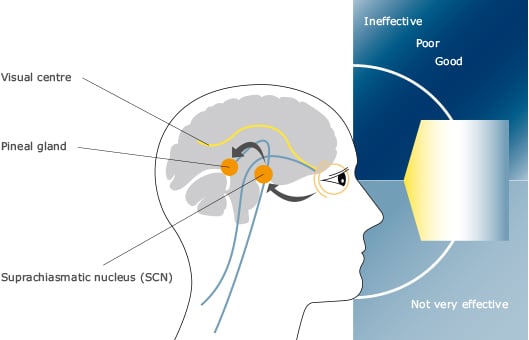
The human visual and hormonal system. Light enters the eye and signals are sent from the retina to the brain’s visual centre and suprachiasmatic nucleus. The most efficient light exposure angle for maximum ganglion cell triggering is from above the horizon. Source: Licht.de
Scientists have been studying the biological impact of light for decades. But it was not until 2002 that they discovered ganglion cells in the retina that are not used for seeing. The newly identified cells respond most sensitively to visible blue light and set the biological clock that synchronises our bodies with the external cycle of day and night.
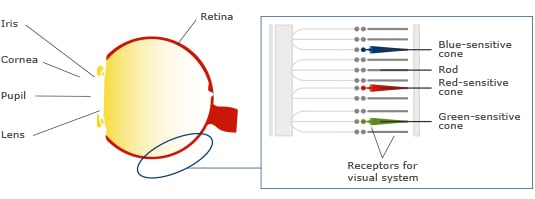
The retina of the human eye contains three photoreceptors: colour-sensitive cones, dim-light-sensitive rods, and blue-light-sensitive ganglion cells.
A major output of the biological clock system is the production of the hormone melatonin – the “sleep hormone”. This hormone’s production in the pineal gland varies with the time of day. Melatonin is secreted at night and has minimal levels during daytime. Increased melatonin suppression triggered by light exposure often coincides with increased feelings of alertness and higher sustained attention.
The hormonal pulse generators
The ganglion cells send signals to the brain and regulate hormone production. The three most important hormones that control the biological rhythms are:
- Melatonin – it makes you tired, slows the body functions and lowers activity in favour of earned rest.
- Cortisol – this, on the other hand, is a stress hormone that is produced from about 3 a.m. It stimulates the metabolism and programs the body for day mode.
- Serotonin – this hormone works as a stimulant and motivator. While the cortisol level in the blood drops throughout the day and thereby acts counter-cyclic to the melatonin level, serotonin helps elevate energy levels.
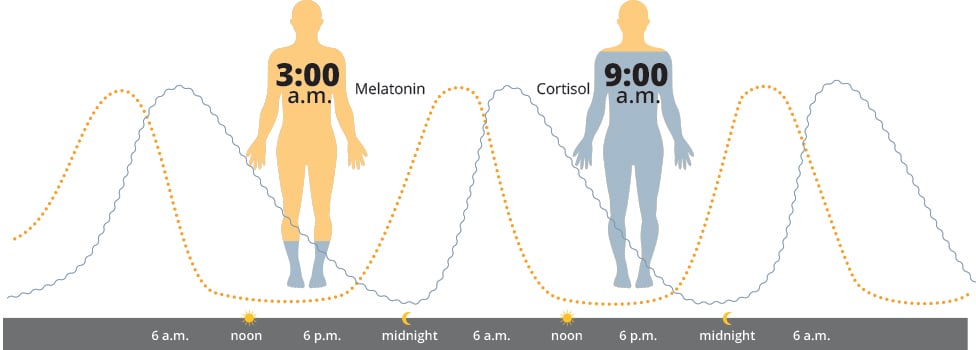
Guiding parameters for Human Centric Lighting
In order to install and program efficient Human Centric Lighting solution, four parameters require careful attention: spectrum, intensity, timing & duration and distribution. Each parameter may be changed as long as one or more of the other parameters are adjusted accordingly.
Spectrum
Understanding the effect of colour temperature
Light is the radiation visible to the human eye in the 380–780 nanometre range. Optical stimuli are registered in the human eye by three different cones, which respond sensitively to red, green or blue radiation. But we do not perceive colours as equally bright. Colours in the yellow-green spectrum at 555 nanometres are perceived as the brightest. The rod cells enable us to see in dim light. They cannot distinguish colours, however. The biologically effective range is the blue colour spectrum between 460-500 nanometres.

The sensitivity curves under daylighting conditions v(λ), nighttime v'(λ) and for circadian effects c(λ)
The ganglion cells are most sensitive to light at 480 nanometres (1). This corresponds to blue light. The equivalent white light will therefore contain a large portion of blue wavelengths and is hence referred to as cool white light, with colour temperatures from 5-6000 Kelvin and above. Research (2) has shown that exposure to light in the blue part of the spectrum results in lower melatonin secretion. In short, we could say that the cool white light that we find much of in sunlight and in certain light sources helps to adjust the circadian phase and results in a higher subjective alertness, core body temperature and heart rate (3). Spectral sensitivity characteristics are defined in documents such as CIE S 026.
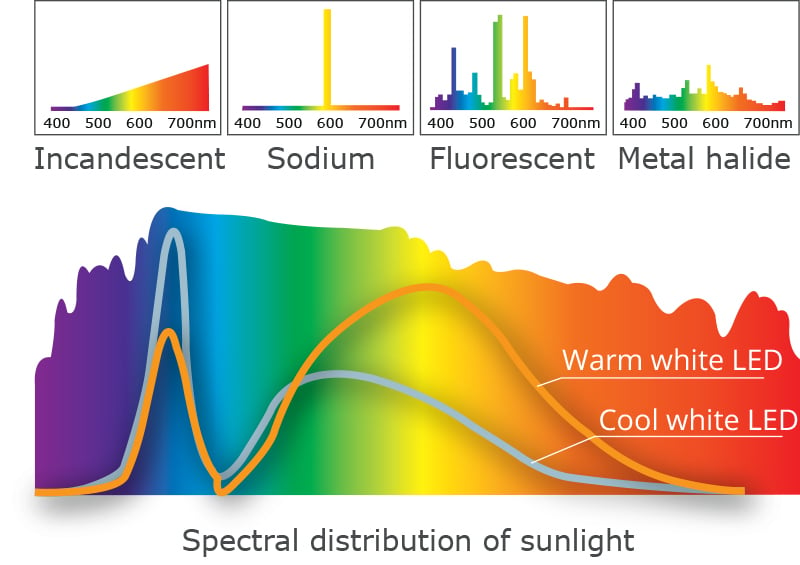
The spectral distributions of various light sources.
Cool white LED light has a higher amount of blue wavelengths, and is therefore more effective when it comes to adjusting circadian rhythms.
Sources
1 Bailes, H.J. and Lucas, R.J. (2013) Human melanopsin forms a pigment maximally sensitive to blue light (lmax _479 nm) supporting activation of Gq/11 and Gi/o signalling cascades. Proc. Biol. Sci. 280, 20122987
2 Brainard et al., 2001 Action spectrum for melatonin regulation in humans: evidence for a novel circadian photoreceptor. The Journal of Neuroscience, 21, 6405-6412.; Thapan et al., 2001 An action spectrum for melatonin suppression: evidence for a novel non-rod, non-cone photoreceptor system in humans. The Journal of Physiology, 535, 261-267.
3 Cajohen et al., 2005 High sensitivity of human melatonin, alertness, thermoregulation, and heart rate to short wavelength light. The Journal of Clinical Endocrinology & Metabolism, 90, 1311-1316.
Intensity
Understanding the effect of light intensity
The melatonin suppression starts at 30 lux and saturates at approximately 1000 lux at eye level. Knowing that melatonin levels saturate above 1000 lux at eye level could be used as a maximum level guideline. This translates to a vertical illumination (Ev), or a cylindrical illuminance Ez, of 1000 lux. (Elderly people with reduced vision will need a higher illumination level). In 2019, Underwriters Laboratories (UL) presented new recommendations for lux level in order to achieve melatonin suppression. The recommendation is for 254 lux on the eye (measured vertically), conditional on the use of indirect light and a colour temperature of 5000 Kelvin. If the colour temperature or light distribution is altered, the recommended lux level will also change. Glamox uses this as a basis when we customise our Human Centric Lighting solutions.
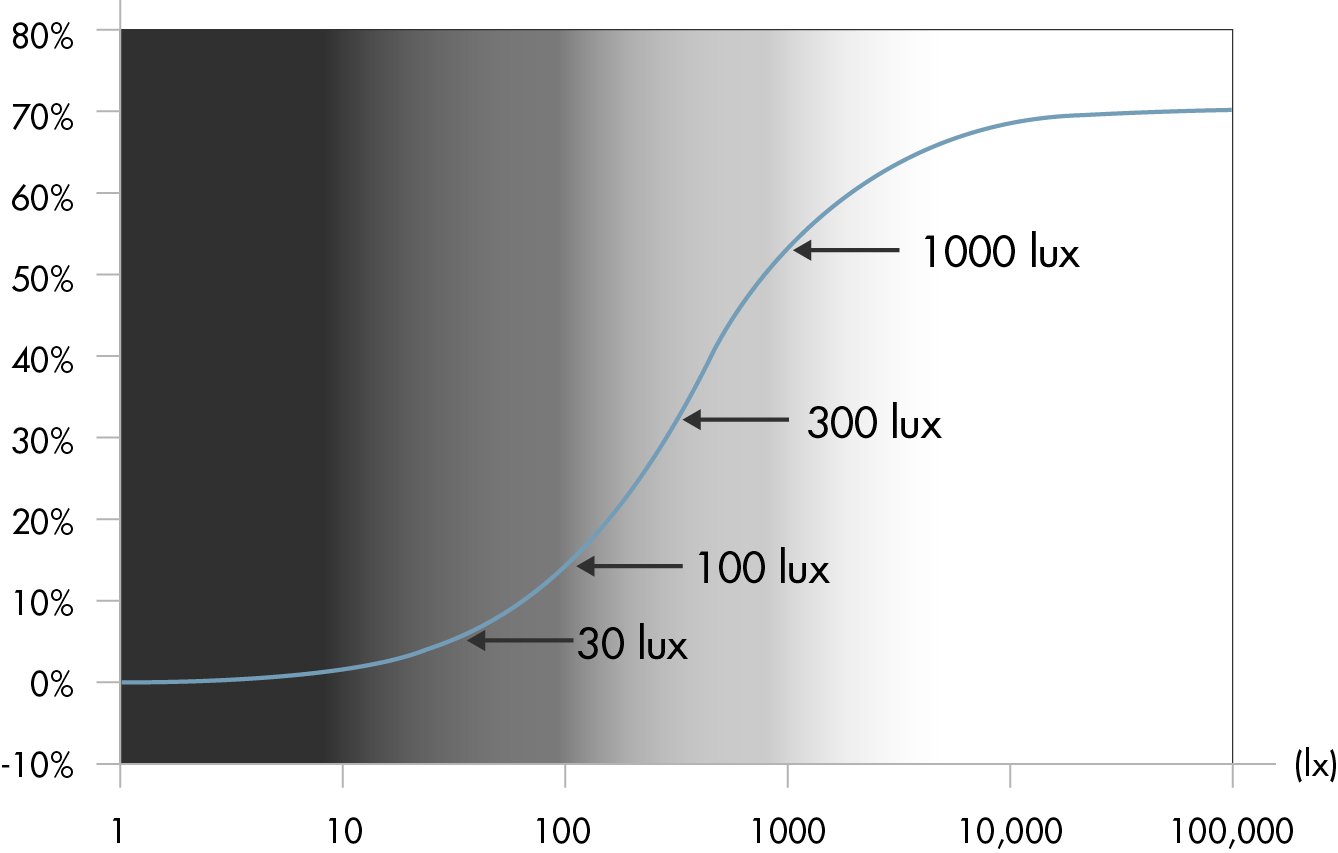
The Underwriters Laboratories (UL) recommend 254 lux at eye level, conditional on the use of indirect light and a colour temperature of 5000 Kelvin.
Because of physical laws, the horizontal illuminance on the work surface (at 0.75 m above floor level) will be 2 or even 3 times higher than at eye level. That may again pose great challenges in terms of glare and energy consumption. Our recommendation is therefore to reduce the light level to a maximum of 250-350 lux at eye level (this corresponds to approx. 750-1000 lux on the work plane) and rather prolong the exposure time. This does not necessarily reduce the energy consumption, but will be beneficial for the lighting conditions.
EN 12464-1 (2021)
The new EN 12464-1 (2021) standard includes Annex B, Additional information on visual and non-visual (non-image forming) effects of light. The annex states the importance of considering the non-visual effects of light when planning the light installation. The new standard now refers to two horizontal illuminance levels – one required level and one modified level. For a typical working environment – for instance, an office – the required value is Ēm, 500 lx and the modified value is Ēm, 1000 lx. This, among other things, creates the opportunity to obtain a light installation that changes in light intensity during the day to enhance people’s wellbeing and stabilise their circadian rhythm.
What is cylindrical illuminance?
EN 12464-1 calls for more light on people’s faces to improve the conditions for visual communication. In areas where good visual communication is important, especially in offices, meeting and teaching areas, Ēz, should have a value of no less than 150 lx with U0 ≥ 0.10. Picturing people’s heads as cylinders, the cylindrical illuminance is the average of all light (measured in lux) that falls on the cylinder.
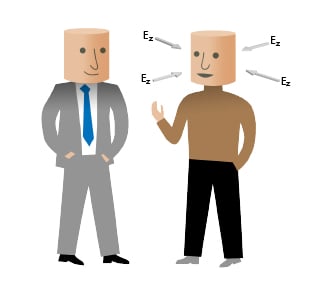
Cylindrical illuminance (Ēz) is the average of all vertical light that hits an imaginary cylinder.
Ēz, is perhaps not the most accurate proxy for illuminance at the eye level, where we want the light to hit, but it is a pragmatic approach with many advantages – the number one advantage being that this is a metric that the lighting planner already understands and uses, and that it’s a value that’s referred to in EN 12464-1. But we should also use vertical light levels (Ēv) as a factor, and the advantage of using Ēv is that these light levels can be verified through measurement. Ēv also refers to light on the eye in the direction of view. The relationship between Ēv/ Ēz, measured or calculated in an activity plane 1.2 m above the floor for sitting people and the task area illuminance Ēm, at 0.75 m is between 1:2 or 1:3. Hence, light at eye level is in most cases lower than light on the work surface.
Maintenance factor
The lamp lumen maintenance factor (LLMF) for Human Centric Lighting solutions should be kept at 1.0. This is because a lighting installation that is dimensioned to an Ēv / Ēz, of 250-300 lux will have enough light to fulfil requirements for both visual task lighting and the wanted biological effects. With time, the lumen output will diminish, but it will still be sufficient to perform the visual tasks. The consequence is, however, that the duration of the circadian-effective light exposure must be prolonged to obtain the same effects as in the beginning. Since no clear guidelines exist on lumen maintenance levels or duration periods, we recommend that the LLMF is set as high as possible.
Sources
1 M. Gibbsa,b, S. Hamptona, L. Morganb, J. Arendta, 2002. Adaptation of the circadian rhythm of 6-sulphatoxymelatonin to a shift schedule of seven nights followed by seven days in offshore oil installation workers.
2 Smith, Revell & Eastman, 2009; Smith and Eastman, 2009 Phase advancing the human circadian clock with blue-enriched polychromatic light.
Timing and duration
Understanding the effects of right timing and duration
Non-visual effects of light are influenced by the time of day.
Light in the morning is the most effective. It tells our biological clock that the day has begun and that bodily functions need to be activated. Conversely, light exposure in the evening will cause melatonin production to be suppressed and make it harder to fall asleep. Exposure at night, before the point that the core body temperature reaches its minimum (nadir) can result in a phase delay, while exposure in the early morning (after nadir) can cause a phase advance. The acute effects on alertness, however, do not depend on time of day. Effects on sustained attention are significant only in the morning (1).
Annex B, Additional information on visual and non-visual (non-image forming) effects of light in EN12464-1 (2021) states the importance of the daily pattern of dark/light cycles, especially around and during periods of sleep. It also states that a certain change to the balance of the light spectrum can be helpful in stabilising circadian rhythms at different times of the day.
Human psychology also plays a role with respect to the timing of colour temperature variations. Preferred light settings may vary with the time of day. Therefore, users should be given the opportunity to adjust colours themselves, preferably when the risk of phase delay or advances is lower.
A general rule of thumb is that the larger the time of exposure, the larger the phase shift (2). But this relationship is not necessarily linear. It may be that people are more sensitive to light in the first part of the light exposure (3). Short durations of bright light exposure may also induce phase shifts in circadian rhythms. The instant effects of bright light on subjective alertness, however, may not be dependent on the duration of exposure. Instead, continuous or repeated exposure is required when activation is intended (4).
Therefore, it is difficult to state clear guidelines with respect to duration. A compromise needs to be made between personal preferences, the wanted phase-shifting effect and energy consumption. A working hypothesis for our Human Centric Lighting installations is to provide phase-advancing, blue-enriched bright light in the late morning to allow for night owls to pass their core body temperature minimum. And we recommend giving users access to alertness-enhancing light during the workday, with moderate duration times. This could be implemented by combining a pre-programmed lighting cycle with individual control over colour temperature and dim levels.
Sources
1 Smolders et al.2012 A higher illuminance induces alertness even during office hours: findings on subjective measures, task performance and heart rate measures. Physiology & Behavior, 107, 7-16.
2 Chang et al., 2012 Human responses to bright light of different durations. Journal of Physiology, 590, 3102-3112.; Dewan et al., 2011 Light-induced changes of the circadian clock of humans: Increasing duration is more effective than increasing light intensity. Sleep, 34, 593-599.
3 St.Hilaire et al., 2012 Human phase response curve to a 1 h pulse of bright white light. Journal of Physiology, 590, 3035-3045 and Rimmer et al., 2000 Dynamic resetting of the human circadian pacemaker by intermittent bright light. American Journal of Physiology – Regulatory Integrative and Comparative Physiology, 279, 1574-1579.
4 Vandewalle et al., 2009 Light as a modulator of cognitive brain function. Trends in Cognitive Sciences, 13, 429-438.
Distribution of light
Understanding the importance of correct light distribution
Light distribution in the room is a combination of the light fixtures’ properties and where you place them in the room.
The ganglion cells of the third photoreceptor are most sensitive in the nasal and lower area of the retina. Our eyes need to be able to perceive bright areas in the room as effectively as possible. Because the receptors that affect our circadian rhythm are particularly sensitive in the lower and nasal part of the eye, the illumination of surfaces in the upper part of the field of view is recommended. We need to light up the ceiling and the vertical surfaces in the room. Light coming from the “right” angle must not be perceived as discomfort glare. This can be done with large illuminated surfaces in the ceiling in combination with wallwashers, or with pendant luminaires with indirect light.
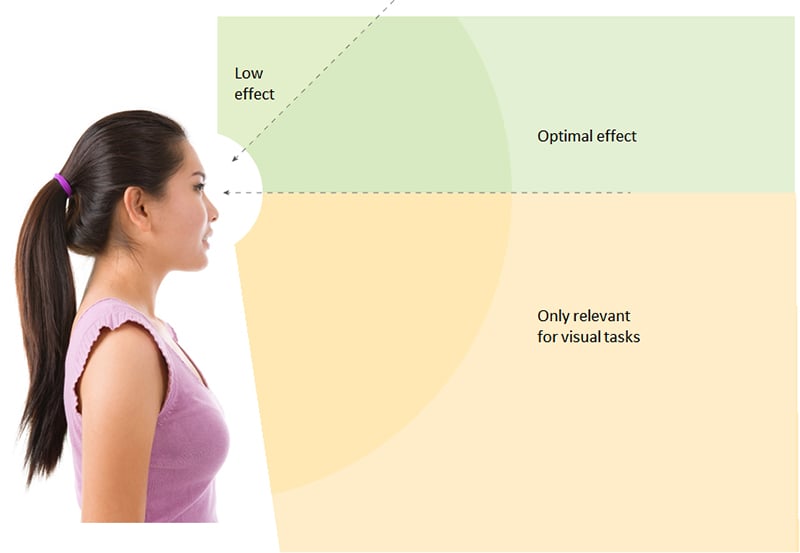
The new revised EN 12464-1 (2021) standard has included the importance of the room brightness in the recommendations to ensure their occupants’ wellbeing and alertness. There are now minimum values for wall, ceiling and also cylindrical brightness in the standard. In a typical working environment in an educational building or an office, the minimum brightness (Ēv value) for walls should be 150 lx and for ceilings, it should be 100 lx. The minimum cylindrical value (Ēz) should be 150 lx.
